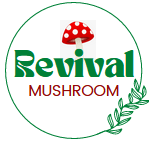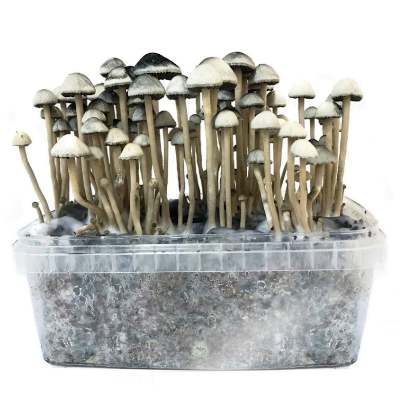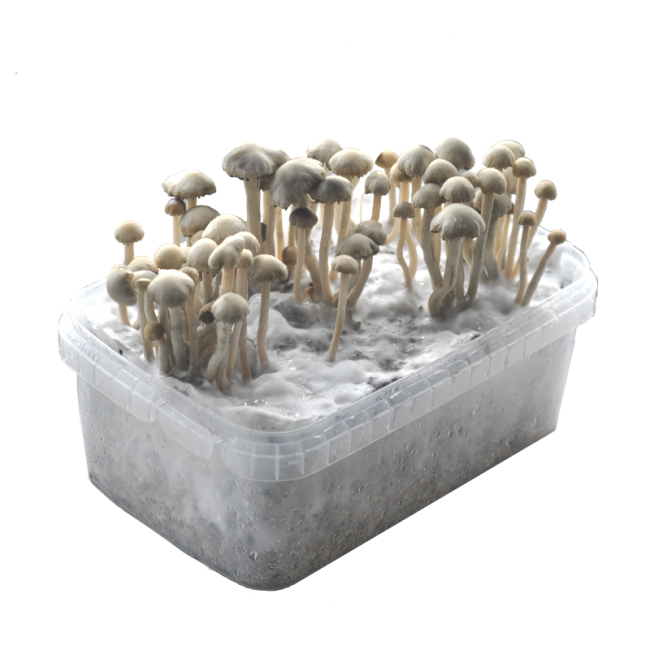Description
Buy Hawaiian Copelandia Magic mushroom grow kit | panaeolus cyanescens online
Buy Hawaiian Copelandia Magic mushroom grow kit | panaeolus cyanescens online. Hawaiian Copelandia mushroom cultivation kit. aka Panaeolus Cyanescens, Copelandia Cyanescens Copelandia papilionacea or Psilocybe Cyanescens (false!)… You may call them anything you want!
If a species has so many names, you know it must be distinct. Panaeolus Cyanescens and Copelandia Cyanescens are the official scientific names. Compared to psilocybe cubensis, the Hawaiian Copelandia is four to six times as effective. And provides a clear and vibrant visual journey.
Instructions | Set-Up | Temperature | FAE & Humidity | Harvest | Dose | Storage | Strain Information | History
Hawaiian Copelandia Panaeolus Cyanescens grow kit
How to grow Hawaiian Copelandia? This has been a quest for years. It’s hard, but now you can give growing Panaeolus Cyanescens a chance with this easy to use grow kit. A few key factors are important:
- Work clean !
- Lots of fresh air : Air the kit, twice a day
- High Humidity : Moist the grow kit once a day
- Do not spray on the pins or mushrooms
Warning: Due cold storage the substrate can have some blue and green spots upon arrival. This does not mean that your kit is contaminated. Just send a picture of the kit to the Support and we can help you determinate if it is something else
Contents of the Hawaiian Copelandia grow kit
- Mycelium box 1200 ml with Panaeolus Cyanescens, Hawaiian strain
- Topsoil (casing layer) black earth like substance
- Grow bag
- Paperclip
Additional items
Storage
We recommend that you start the kit as soon as possible. If you do not want to use it right away. Keep the kit refrigerated between 5 – 7 degrees Celsius. Only use a cleaned refrigerator. Start the kit within a week after rival.
Hawaiian Copelandia Panaeolus Cyanescens grow kit Instructions
Work clean !
Clean your work area and wash your hands Use gloves and a face mask if you have them. Work with your arms stretched so the kit is an arms length a way form you. This way you can not breath or cough on the kit or in the grow bag.
Start your Hawaiian Copelandia grow kit:
- Take out the contents of the kit. The substrate container, topsoil (casing layer) container, the growbag (humidity bag) the paperclip
- Spread the black top soil (casing layer) over the substrate, smooth it out evenly over the surface with your fingers.
- Put the kit in the grow bag.
- Mist the black top soil layer, until it is very mosit but not soaked with water.
- Add fresh air and close the bag with the paper clip.
- Everyday spray the sides of the grow bag with 1-2 sprays of water, from a misting bottle. And add fresh air by squeezing the bag and then opening it again, allowing new air to come inside.
- 5 – 17 days after starting your Copelandia grow kit, pins will begin to form (small mushrooms, tat appeear like small dots)
- DO NOT SPRAY the pins or mushrooms directly. But take the mushroom grow kit out of the growbag, add fresh air, spray the bag lightly to increase humidity. Put the kit back in the grow bag and close the bag.
- 5-7 days after pinning most mushrooms will be grown and are ready to pick.
- Prepare the kit for the next flush, by misting the top layer with lots of water. Spray until one or to centimeters of water accumulates at the bottom of the grow kit. You can pour the water out of the kit when you the new flush begins to grow.
Set-Up
The set-up or positioning of your Hawaiian Copelandia kit is very important.
- Your cultivation area should be clean and disinfected.
- Pick a spot off the ground, preferably between knee and eye height. Or on top of a cupboard
- Do NOT cultivate in your bathroom, toilet or cellar. These rooms often contain other molds or bacteria.
- Do NOT put the kit in a box, container or other closed environment. The grow kit needs fresh air and airflow. With no air you will kill the mycelium.
- Do NOT put the kit in direct sunlight. A bright place in the house is perfect.
Temperature
Fruiting temperature for the Panaeolus Cyanescens mushrooms is around 24 degrees Celsius, more or less the same as you grow psilocybe cubensis mushrooms. If you keep ypur grow kit around that temperature the kit will flourish. We notice that if the kit cultivation temperature is lower then 19 degrees the kit will not preform as good.
- Colonization temperature 26-29°C
- Fruiting temperature 23-26°C
Fresh Air Exchange (FAE)
The mycelium and mushrooms need fresh air to develop. that is why it is important to air the grow bag 2 times a day. You can add the fresh air by doing the following:
- Close your doors and windows to avoid draft
- Clean your hands or use gloves
- Open the grow bag, by removing the clip and unfolding the top.
- Now squeeze the bag and open it to add the fresh air.
- Do this 3-4 times and the kit will have enough fresh air for the day
- Fold the top and close it with the clips
- Air the kit in the mornings and at night.
Humidity
After introducing fresh air to the grow bag, it is time to boost the relative humidity. This may be accomplished by spraying the kit’s top soil and the inside of the grow bag. Make it moist not wet. When the first little mushrooms appear in the grow kit, remove the substrate kit from the humidity bag and spray solely in the bag! The growth of Hawaiian Copelandia mushrooms will cease if they get moist. Never apply pesticides on mushrooms.
Harvest
The perfect time to harvest your Hawaiian Copelandia kit is about 24-36 hours after the Panaeolus Cyanescens mushrooms drops their spores. The caps turn a bit grayish white.You will see some black spores on the caps too. Time to pick your mushrooms! Unlike the psilocybe cubensis the Panaeolus Cyanescens does not have a veil. The caps just open and drop their spores.
How to pick the mushrooms from the Copelandia mushroom kit?
Gently knock the Panaeolus Cyanescens mushrooms over, snap them at the base. They will detach themselves form the substrate and are ready for use.
Spore Printing
Panaeolus cyanescens produces a black spore print that at best can be obtained when the caps are opening. This way you can store the genetics of the mushroom strain and research the spores under a microscope.
- Harvest a mushroom that has it cap open
- Cut the cap of the stem
- Place the cap with the gills down on foil or a microscopy glass
- Cover the cap and foil with a glass bowl or a contrainer.
- Wait for 1-2 days
- Remove the cap from the surface
- You print is ready!
- Secure the print by folding the foil and store it in a zip lock bag
Strain information
Panaeolus cyanescens, also known as Copelandia cyanescens and blue meanies are a hallucinogenic mushroom that contains psilocybin, serotonin, and urea. Binomial name :Panaeolus cyanescens (Berkeley & Broome) Singer
Scientific classification
- Kingdom: Fungi
- Phylum: Basidiomycota
- Class: Hymenomycetes
- Order: Agaricales
- Familly: Bolbitiacaeae
- Genus: Panaeolus
- Species: Cyanescens
- Strain: Hawaiian
- Habitat: Bovine Dung
- Climate: Tropical
- Strain Origin: Hawaii
- Cap: 10-40 mm in diameter, hemispheric expanding to broadly convex to nearly plane with age. Brownish maturing to grayish white. Flesh readily bruising bluish.
- Stem: 85-120 mm in length. Typically equal, sometimes slightly enlarged at base. Yellowish to gray bruising bluish.
- Gills: Attachment adnexed. Mottled grayish coloration in young fruit bodies becoming black in maturity.
- Spores: Black, lemonshaped on 4-spored basidia
- Substrate: Dung, straw, compost.
Habitat:
Panaeolus cyanescens is a coprophilous, dung-inhabiting, species which grows in tropical and neotropical areas in both hemispheres. It has been found in Africa Australia, Bali, Belize, Brasil, Borneo, the Caribbean , Puerto Rico, Costa Rica, India, Malaysia, Indonesia , Sri Lanka, Cambodia, Thailand, Europe Japan, Mexico, Oceania (including Fiji and Samoa), the Philippines, South America, Tasmania, and the United States. (source wikipedia)
History
The history of the Panaeolus cyanescens is poorly known. There are no mushroom archaeological finds. And since they were often accessible alongside other well-known mushroom species such as psilocybe cubensis and amanita muscaria, it is likely that they were utilized instead.
In Indonesia, the Panaeolus cyanescens was and still is utilized for ceremonial, celebratory, and recreational purposes. Indonesian Batik artists would draw influence from the Pan Cyans, which explains the vivid and hallucinogenic style of their work.
When their popularity increased in 1980, the mushrooms were marketed to tourists in Bali, Java, and Sumatra.
On Samoa, the indigenous people referred the mushrooms by various names, depending on the mental condition induced by the pan cyans or the method of production. As Taepovi, which means “cow patty,” Pulouaitu, which means “spirit home,” and Faleaitu, which means “comic.” In the 1970s, Samoan teenagers apparently discovered the psychoactive properties of the Panaeolus cyanescens fungus.
Panaeolus cyanescens occurs in the Netherlands in the 1990s, distributed by home growers, and soon afterwards in’smartshops’ as Hawaiians or Balinees. Even though Panaeolus cyanescens are native to tropical regions, the specimen that was studied for its psilocibine was obtained in a French garden. Blue meanies, Pan cyan, Hawaiian blue meanies, blauender dungerling, falterdungerling (German), jambur/jamur (Indonesian), and tenkech are alternative names for Panaeolus cyanescens (Chol).
Taxonomy History
In 1871 the Pan Cyans were named as Agaricus cyanescens by Berkeley and Broome. Years later the name Copelandia papilionacea was given by Bresadola from the Philippines,; it was then named Copelandia cyanescens by Singer in 1951. The species was named Panaeolus cyanescens by Saccardo in 1887, which is now its official formal name.
Responsible use and Harm Reduction
Mushroom cultivation is not without danger. Only grow mushrooms if it is permitted in your country. The grow kits are designed for small-scale home cultivation and spore printing for research. Panaeolus cyanescens is known to have greater alkaloid concentrations than other mushroom species. Please use caution and read our page on harm reduction.
Dosage
Dosing mushrooms and determining the correct dosage relies on a number of factors, including the mushroom species, whether they are fresh or dried, your weight, and the goal of your trip. Before embarking on a wonderful adventure, learn more about dosage calculation, trip levels, and safe use. Evena warns that the Panaeolus cyanescens Hawaiian Copelandia mushrooms are quite strong. A modest quantity of cubensis will surpass any journey.
Average dosage for the Hawaiian Copelandia Panaeolus cyanescens mushrooms:
- Threshold dose : 0,15 gram dry / 1-2 gram fresh
- Light dose: 0,2 – 0,4 grams dry / 4 grams fresh
- Medium dose: 0,5 – 0,7 grams dry / 7 grams fresh
- Heavy dose: 0,8 – 1,2 grams dry / 12 grams fresh
Effects
Active substances in various concentrations are the following Alkaloids:
- Psilocybin
- Psilocin
- Baeosyctin
- Tryptophan
- Tryptamine
- Serotonin




Reviews
There are no reviews yet.